Business Research: Outsourcing Functions, Advantages and Disadvantages
VerifiedAdded on 2020/03/02
|12
|3094
|82
Report
AI Summary
This report provides a comprehensive analysis of outsourcing in business, examining both its advantages and disadvantages. The introduction highlights the growing importance of outsourcing as a strategic tool for businesses, emphasizing its potential benefits for both new and established companies. The report then delves into the project objectives, which are to understand the advantages and disadvantages of outsourcing processes. The scope of the project involves a detailed investigation using various reviewed and published resources. The literature review explores the advantages of outsourcing, including expert operations, cost reduction, shift of focus, enhanced innovation, and workload management. It also discusses the disadvantages, such as de-motivation, limited managerial authority, risk to plans, data security issues, hidden costs, no finance sharing, and public backlash. The report draws on various sources such as journals, magazines, conference papers, books, and articles to provide a thorough understanding of the topic, aiming to identify gaps in the literature and compare different materials. The conclusion summarizes the key findings and provides an overview of the debates and discussions on outsourcing in the business world. The report provides a comprehensive overview of the subject matter.
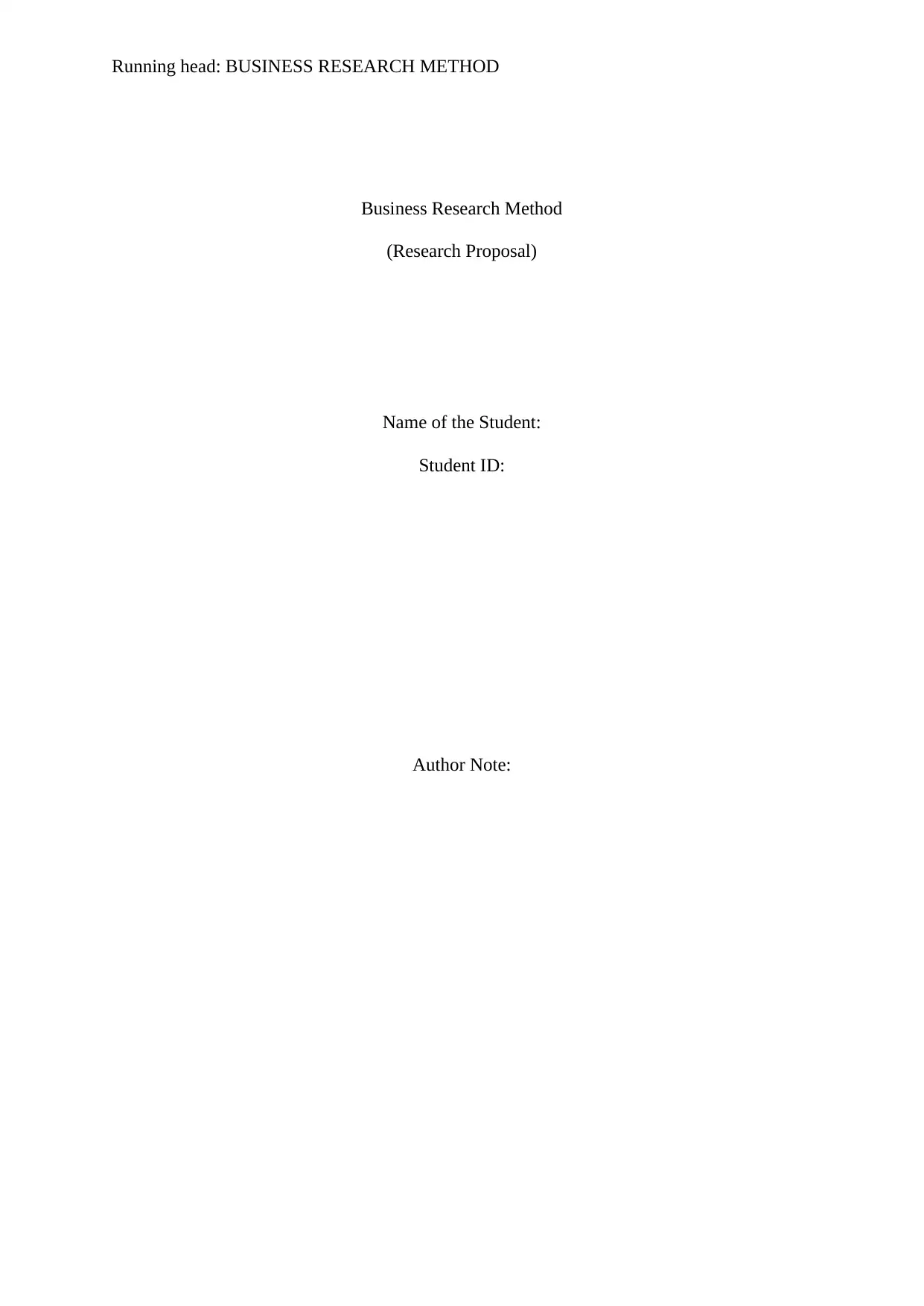
Running head: BUSINESS RESEARCH METHOD
Business Research Method
(Research Proposal)
Name of the Student:
Student ID:
Author Note:
Business Research Method
(Research Proposal)
Name of the Student:
Student ID:
Author Note:
Paraphrase This Document
Need a fresh take? Get an instant paraphrase of this document with our AI Paraphraser
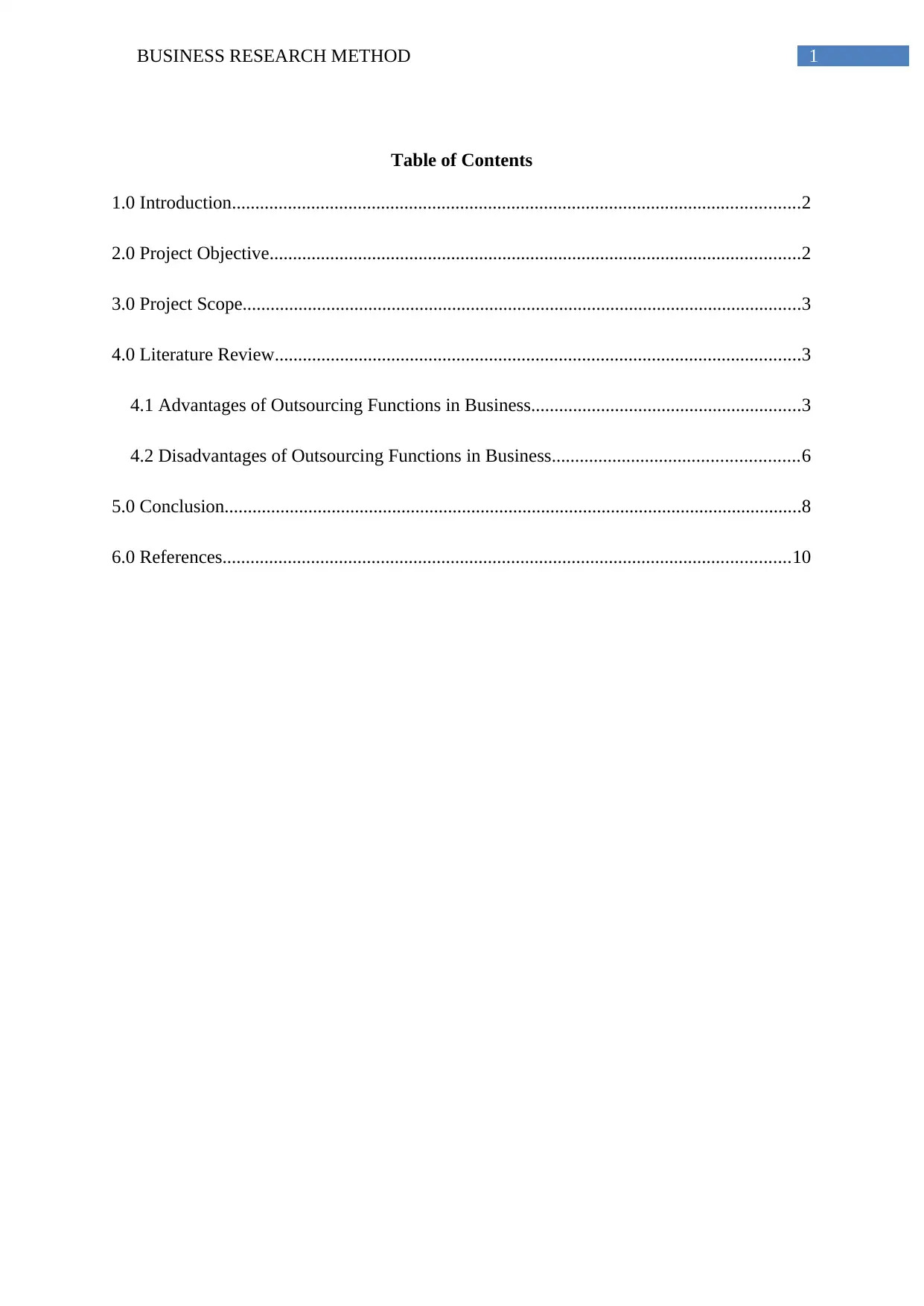
1BUSINESS RESEARCH METHOD
Table of Contents
1.0 Introduction..........................................................................................................................2
2.0 Project Objective..................................................................................................................2
3.0 Project Scope........................................................................................................................3
4.0 Literature Review.................................................................................................................3
4.1 Advantages of Outsourcing Functions in Business..........................................................3
4.2 Disadvantages of Outsourcing Functions in Business.....................................................6
5.0 Conclusion............................................................................................................................8
6.0 References..........................................................................................................................10
Table of Contents
1.0 Introduction..........................................................................................................................2
2.0 Project Objective..................................................................................................................2
3.0 Project Scope........................................................................................................................3
4.0 Literature Review.................................................................................................................3
4.1 Advantages of Outsourcing Functions in Business..........................................................3
4.2 Disadvantages of Outsourcing Functions in Business.....................................................6
5.0 Conclusion............................................................................................................................8
6.0 References..........................................................................................................................10
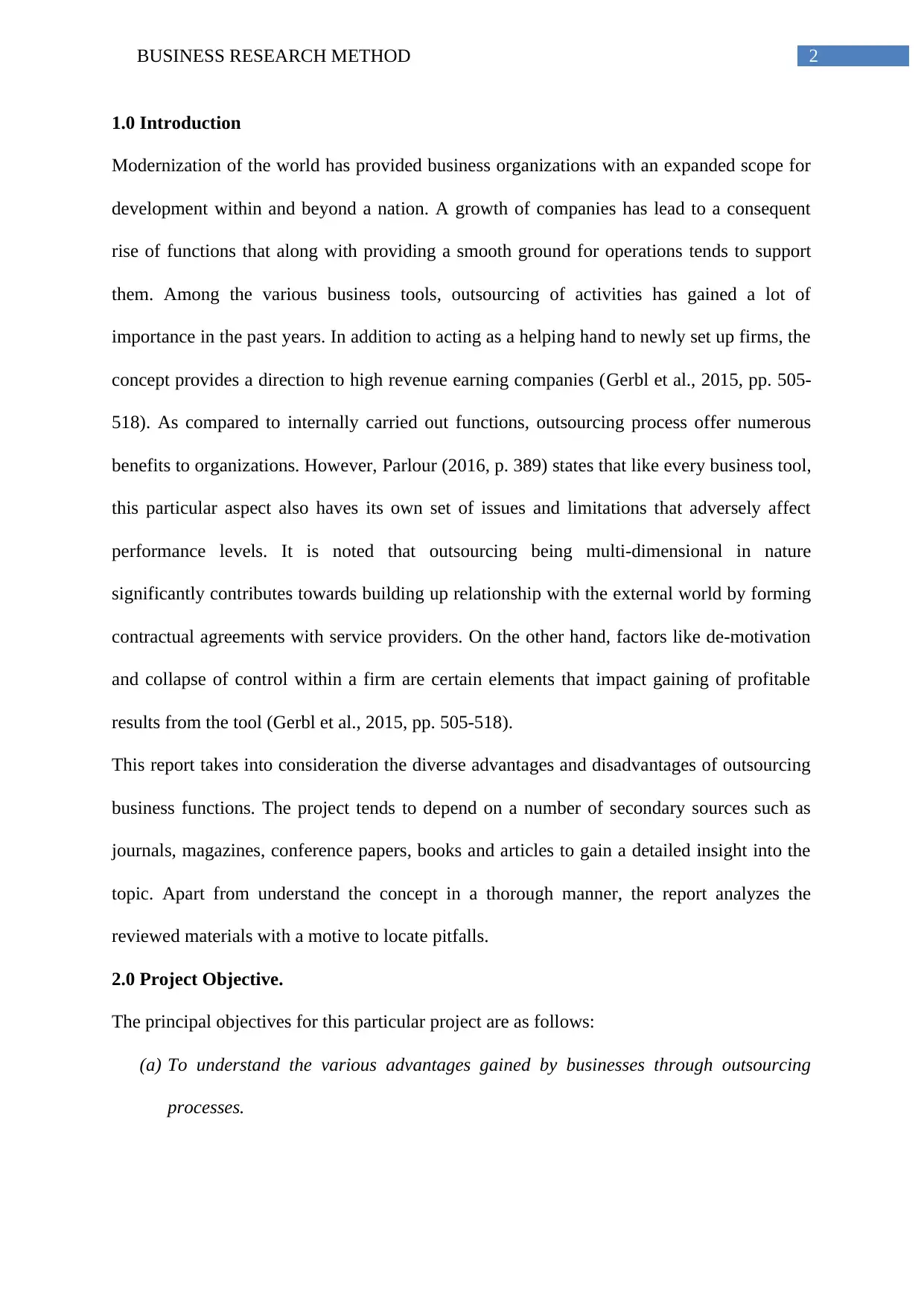
2BUSINESS RESEARCH METHOD
1.0 Introduction
Modernization of the world has provided business organizations with an expanded scope for
development within and beyond a nation. A growth of companies has lead to a consequent
rise of functions that along with providing a smooth ground for operations tends to support
them. Among the various business tools, outsourcing of activities has gained a lot of
importance in the past years. In addition to acting as a helping hand to newly set up firms, the
concept provides a direction to high revenue earning companies (Gerbl et al., 2015, pp. 505-
518). As compared to internally carried out functions, outsourcing process offer numerous
benefits to organizations. However, Parlour (2016, p. 389) states that like every business tool,
this particular aspect also haves its own set of issues and limitations that adversely affect
performance levels. It is noted that outsourcing being multi-dimensional in nature
significantly contributes towards building up relationship with the external world by forming
contractual agreements with service providers. On the other hand, factors like de-motivation
and collapse of control within a firm are certain elements that impact gaining of profitable
results from the tool (Gerbl et al., 2015, pp. 505-518).
This report takes into consideration the diverse advantages and disadvantages of outsourcing
business functions. The project tends to depend on a number of secondary sources such as
journals, magazines, conference papers, books and articles to gain a detailed insight into the
topic. Apart from understand the concept in a thorough manner, the report analyzes the
reviewed materials with a motive to locate pitfalls.
2.0 Project Objective.
The principal objectives for this particular project are as follows:
(a) To understand the various advantages gained by businesses through outsourcing
processes.
1.0 Introduction
Modernization of the world has provided business organizations with an expanded scope for
development within and beyond a nation. A growth of companies has lead to a consequent
rise of functions that along with providing a smooth ground for operations tends to support
them. Among the various business tools, outsourcing of activities has gained a lot of
importance in the past years. In addition to acting as a helping hand to newly set up firms, the
concept provides a direction to high revenue earning companies (Gerbl et al., 2015, pp. 505-
518). As compared to internally carried out functions, outsourcing process offer numerous
benefits to organizations. However, Parlour (2016, p. 389) states that like every business tool,
this particular aspect also haves its own set of issues and limitations that adversely affect
performance levels. It is noted that outsourcing being multi-dimensional in nature
significantly contributes towards building up relationship with the external world by forming
contractual agreements with service providers. On the other hand, factors like de-motivation
and collapse of control within a firm are certain elements that impact gaining of profitable
results from the tool (Gerbl et al., 2015, pp. 505-518).
This report takes into consideration the diverse advantages and disadvantages of outsourcing
business functions. The project tends to depend on a number of secondary sources such as
journals, magazines, conference papers, books and articles to gain a detailed insight into the
topic. Apart from understand the concept in a thorough manner, the report analyzes the
reviewed materials with a motive to locate pitfalls.
2.0 Project Objective.
The principal objectives for this particular project are as follows:
(a) To understand the various advantages gained by businesses through outsourcing
processes.
⊘ This is a preview!⊘
Do you want full access?
Subscribe today to unlock all pages.

Trusted by 1+ million students worldwide
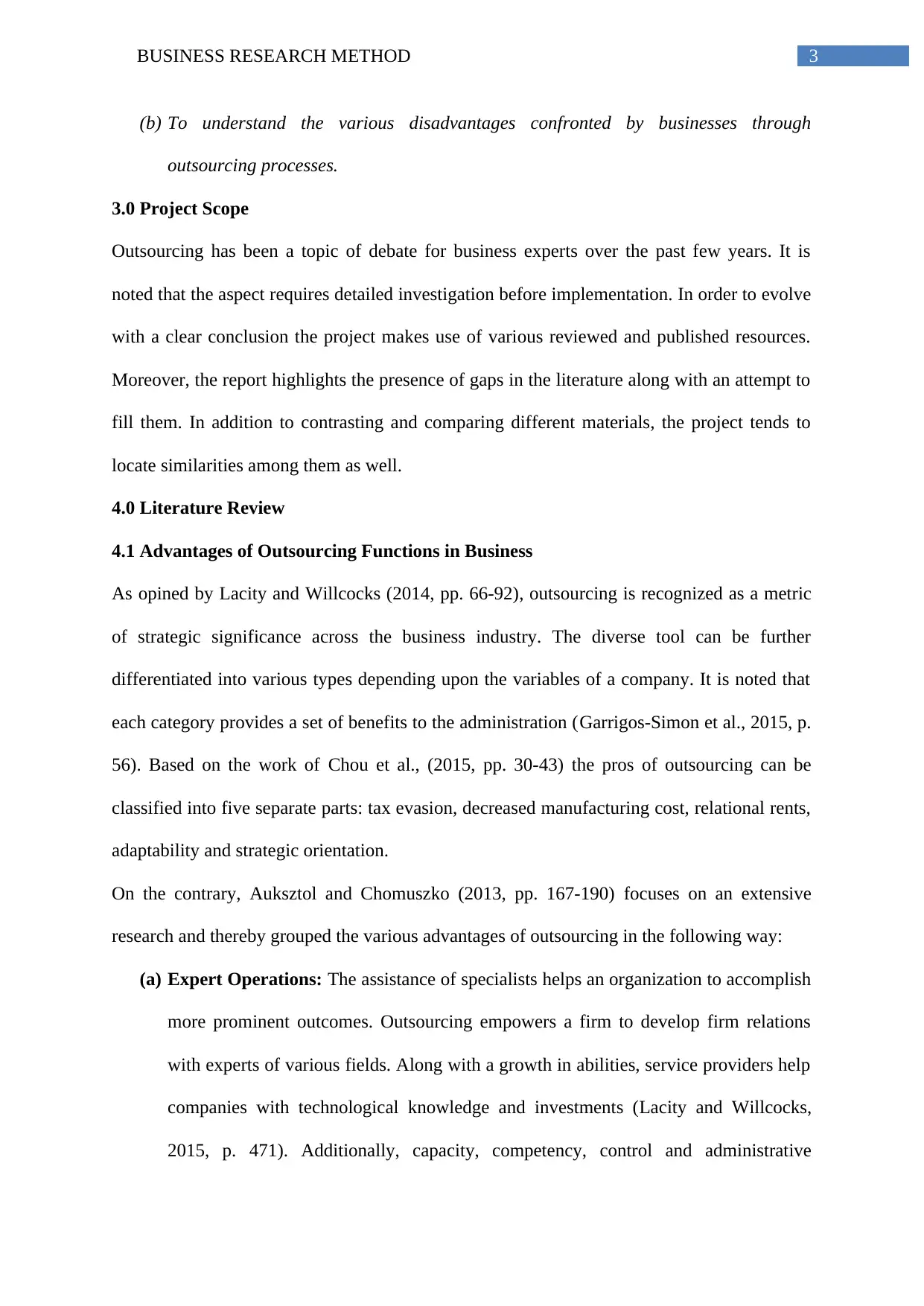
3BUSINESS RESEARCH METHOD
(b) To understand the various disadvantages confronted by businesses through
outsourcing processes.
3.0 Project Scope
Outsourcing has been a topic of debate for business experts over the past few years. It is
noted that the aspect requires detailed investigation before implementation. In order to evolve
with a clear conclusion the project makes use of various reviewed and published resources.
Moreover, the report highlights the presence of gaps in the literature along with an attempt to
fill them. In addition to contrasting and comparing different materials, the project tends to
locate similarities among them as well.
4.0 Literature Review
4.1 Advantages of Outsourcing Functions in Business
As opined by Lacity and Willcocks (2014, pp. 66-92), outsourcing is recognized as a metric
of strategic significance across the business industry. The diverse tool can be further
differentiated into various types depending upon the variables of a company. It is noted that
each category provides a set of benefits to the administration (Garrigos-Simon et al., 2015, p.
56). Based on the work of Chou et al., (2015, pp. 30-43) the pros of outsourcing can be
classified into five separate parts: tax evasion, decreased manufacturing cost, relational rents,
adaptability and strategic orientation.
On the contrary, Auksztol and Chomuszko (2013, pp. 167-190) focuses on an extensive
research and thereby grouped the various advantages of outsourcing in the following way:
(a) Expert Operations: The assistance of specialists helps an organization to accomplish
more prominent outcomes. Outsourcing empowers a firm to develop firm relations
with experts of various fields. Along with a growth in abilities, service providers help
companies with technological knowledge and investments (Lacity and Willcocks,
2015, p. 471). Additionally, capacity, competency, control and administrative
(b) To understand the various disadvantages confronted by businesses through
outsourcing processes.
3.0 Project Scope
Outsourcing has been a topic of debate for business experts over the past few years. It is
noted that the aspect requires detailed investigation before implementation. In order to evolve
with a clear conclusion the project makes use of various reviewed and published resources.
Moreover, the report highlights the presence of gaps in the literature along with an attempt to
fill them. In addition to contrasting and comparing different materials, the project tends to
locate similarities among them as well.
4.0 Literature Review
4.1 Advantages of Outsourcing Functions in Business
As opined by Lacity and Willcocks (2014, pp. 66-92), outsourcing is recognized as a metric
of strategic significance across the business industry. The diverse tool can be further
differentiated into various types depending upon the variables of a company. It is noted that
each category provides a set of benefits to the administration (Garrigos-Simon et al., 2015, p.
56). Based on the work of Chou et al., (2015, pp. 30-43) the pros of outsourcing can be
classified into five separate parts: tax evasion, decreased manufacturing cost, relational rents,
adaptability and strategic orientation.
On the contrary, Auksztol and Chomuszko (2013, pp. 167-190) focuses on an extensive
research and thereby grouped the various advantages of outsourcing in the following way:
(a) Expert Operations: The assistance of specialists helps an organization to accomplish
more prominent outcomes. Outsourcing empowers a firm to develop firm relations
with experts of various fields. Along with a growth in abilities, service providers help
companies with technological knowledge and investments (Lacity and Willcocks,
2015, p. 471). Additionally, capacity, competency, control and administrative
Paraphrase This Document
Need a fresh take? Get an instant paraphrase of this document with our AI Paraphraser
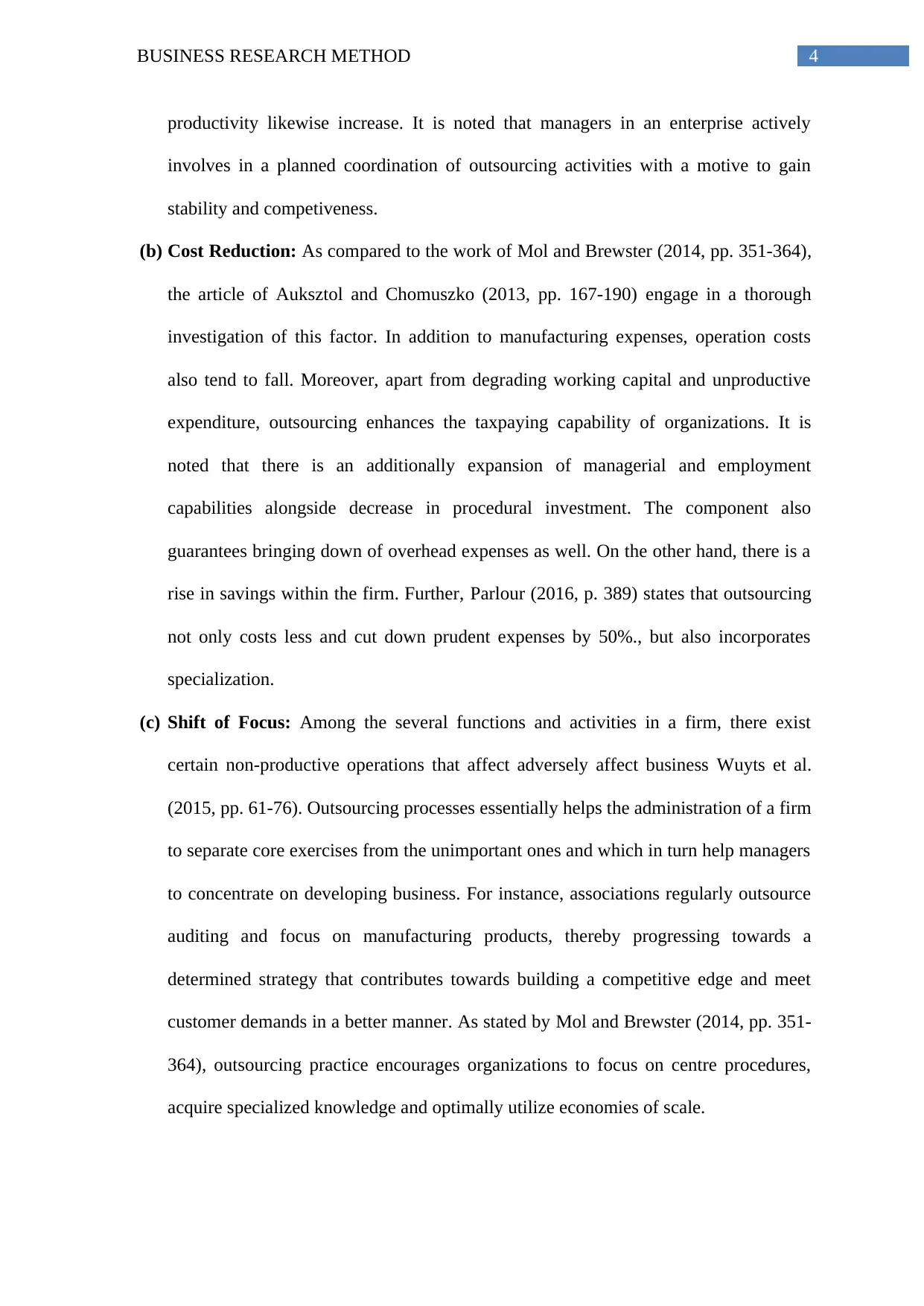
4BUSINESS RESEARCH METHOD
productivity likewise increase. It is noted that managers in an enterprise actively
involves in a planned coordination of outsourcing activities with a motive to gain
stability and competiveness.
(b) Cost Reduction: As compared to the work of Mol and Brewster (2014, pp. 351-364),
the article of Auksztol and Chomuszko (2013, pp. 167-190) engage in a thorough
investigation of this factor. In addition to manufacturing expenses, operation costs
also tend to fall. Moreover, apart from degrading working capital and unproductive
expenditure, outsourcing enhances the taxpaying capability of organizations. It is
noted that there is an additionally expansion of managerial and employment
capabilities alongside decrease in procedural investment. The component also
guarantees bringing down of overhead expenses as well. On the other hand, there is a
rise in savings within the firm. Further, Parlour (2016, p. 389) states that outsourcing
not only costs less and cut down prudent expenses by 50%., but also incorporates
specialization.
(c) Shift of Focus: Among the several functions and activities in a firm, there exist
certain non-productive operations that affect adversely affect business Wuyts et al.
(2015, pp. 61-76). Outsourcing processes essentially helps the administration of a firm
to separate core exercises from the unimportant ones and which in turn help managers
to concentrate on developing business. For instance, associations regularly outsource
auditing and focus on manufacturing products, thereby progressing towards a
determined strategy that contributes towards building a competitive edge and meet
customer demands in a better manner. As stated by Mol and Brewster (2014, pp. 351-
364), outsourcing practice encourages organizations to focus on centre procedures,
acquire specialized knowledge and optimally utilize economies of scale.
productivity likewise increase. It is noted that managers in an enterprise actively
involves in a planned coordination of outsourcing activities with a motive to gain
stability and competiveness.
(b) Cost Reduction: As compared to the work of Mol and Brewster (2014, pp. 351-364),
the article of Auksztol and Chomuszko (2013, pp. 167-190) engage in a thorough
investigation of this factor. In addition to manufacturing expenses, operation costs
also tend to fall. Moreover, apart from degrading working capital and unproductive
expenditure, outsourcing enhances the taxpaying capability of organizations. It is
noted that there is an additionally expansion of managerial and employment
capabilities alongside decrease in procedural investment. The component also
guarantees bringing down of overhead expenses as well. On the other hand, there is a
rise in savings within the firm. Further, Parlour (2016, p. 389) states that outsourcing
not only costs less and cut down prudent expenses by 50%., but also incorporates
specialization.
(c) Shift of Focus: Among the several functions and activities in a firm, there exist
certain non-productive operations that affect adversely affect business Wuyts et al.
(2015, pp. 61-76). Outsourcing processes essentially helps the administration of a firm
to separate core exercises from the unimportant ones and which in turn help managers
to concentrate on developing business. For instance, associations regularly outsource
auditing and focus on manufacturing products, thereby progressing towards a
determined strategy that contributes towards building a competitive edge and meet
customer demands in a better manner. As stated by Mol and Brewster (2014, pp. 351-
364), outsourcing practice encourages organizations to focus on centre procedures,
acquire specialized knowledge and optimally utilize economies of scale.
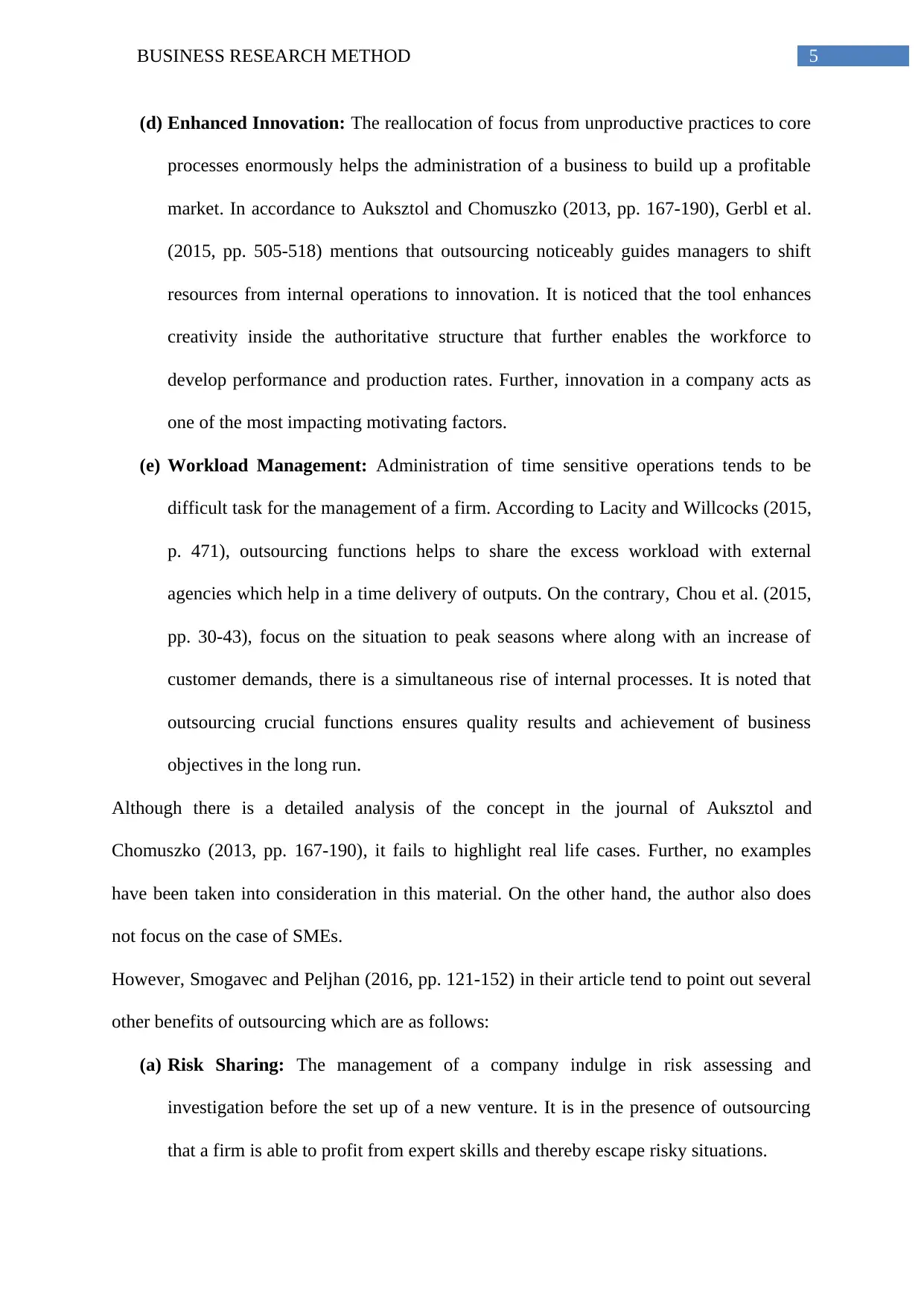
5BUSINESS RESEARCH METHOD
(d) Enhanced Innovation: The reallocation of focus from unproductive practices to core
processes enormously helps the administration of a business to build up a profitable
market. In accordance to Auksztol and Chomuszko (2013, pp. 167-190), Gerbl et al.
(2015, pp. 505-518) mentions that outsourcing noticeably guides managers to shift
resources from internal operations to innovation. It is noticed that the tool enhances
creativity inside the authoritative structure that further enables the workforce to
develop performance and production rates. Further, innovation in a company acts as
one of the most impacting motivating factors.
(e) Workload Management: Administration of time sensitive operations tends to be
difficult task for the management of a firm. According to Lacity and Willcocks (2015,
p. 471), outsourcing functions helps to share the excess workload with external
agencies which help in a time delivery of outputs. On the contrary, Chou et al. (2015,
pp. 30-43), focus on the situation to peak seasons where along with an increase of
customer demands, there is a simultaneous rise of internal processes. It is noted that
outsourcing crucial functions ensures quality results and achievement of business
objectives in the long run.
Although there is a detailed analysis of the concept in the journal of Auksztol and
Chomuszko (2013, pp. 167-190), it fails to highlight real life cases. Further, no examples
have been taken into consideration in this material. On the other hand, the author also does
not focus on the case of SMEs.
However, Smogavec and Peljhan (2016, pp. 121-152) in their article tend to point out several
other benefits of outsourcing which are as follows:
(a) Risk Sharing: The management of a company indulge in risk assessing and
investigation before the set up of a new venture. It is in the presence of outsourcing
that a firm is able to profit from expert skills and thereby escape risky situations.
(d) Enhanced Innovation: The reallocation of focus from unproductive practices to core
processes enormously helps the administration of a business to build up a profitable
market. In accordance to Auksztol and Chomuszko (2013, pp. 167-190), Gerbl et al.
(2015, pp. 505-518) mentions that outsourcing noticeably guides managers to shift
resources from internal operations to innovation. It is noticed that the tool enhances
creativity inside the authoritative structure that further enables the workforce to
develop performance and production rates. Further, innovation in a company acts as
one of the most impacting motivating factors.
(e) Workload Management: Administration of time sensitive operations tends to be
difficult task for the management of a firm. According to Lacity and Willcocks (2015,
p. 471), outsourcing functions helps to share the excess workload with external
agencies which help in a time delivery of outputs. On the contrary, Chou et al. (2015,
pp. 30-43), focus on the situation to peak seasons where along with an increase of
customer demands, there is a simultaneous rise of internal processes. It is noted that
outsourcing crucial functions ensures quality results and achievement of business
objectives in the long run.
Although there is a detailed analysis of the concept in the journal of Auksztol and
Chomuszko (2013, pp. 167-190), it fails to highlight real life cases. Further, no examples
have been taken into consideration in this material. On the other hand, the author also does
not focus on the case of SMEs.
However, Smogavec and Peljhan (2016, pp. 121-152) in their article tend to point out several
other benefits of outsourcing which are as follows:
(a) Risk Sharing: The management of a company indulge in risk assessing and
investigation before the set up of a new venture. It is in the presence of outsourcing
that a firm is able to profit from expert skills and thereby escape risky situations.
⊘ This is a preview!⊘
Do you want full access?
Subscribe today to unlock all pages.

Trusted by 1+ million students worldwide
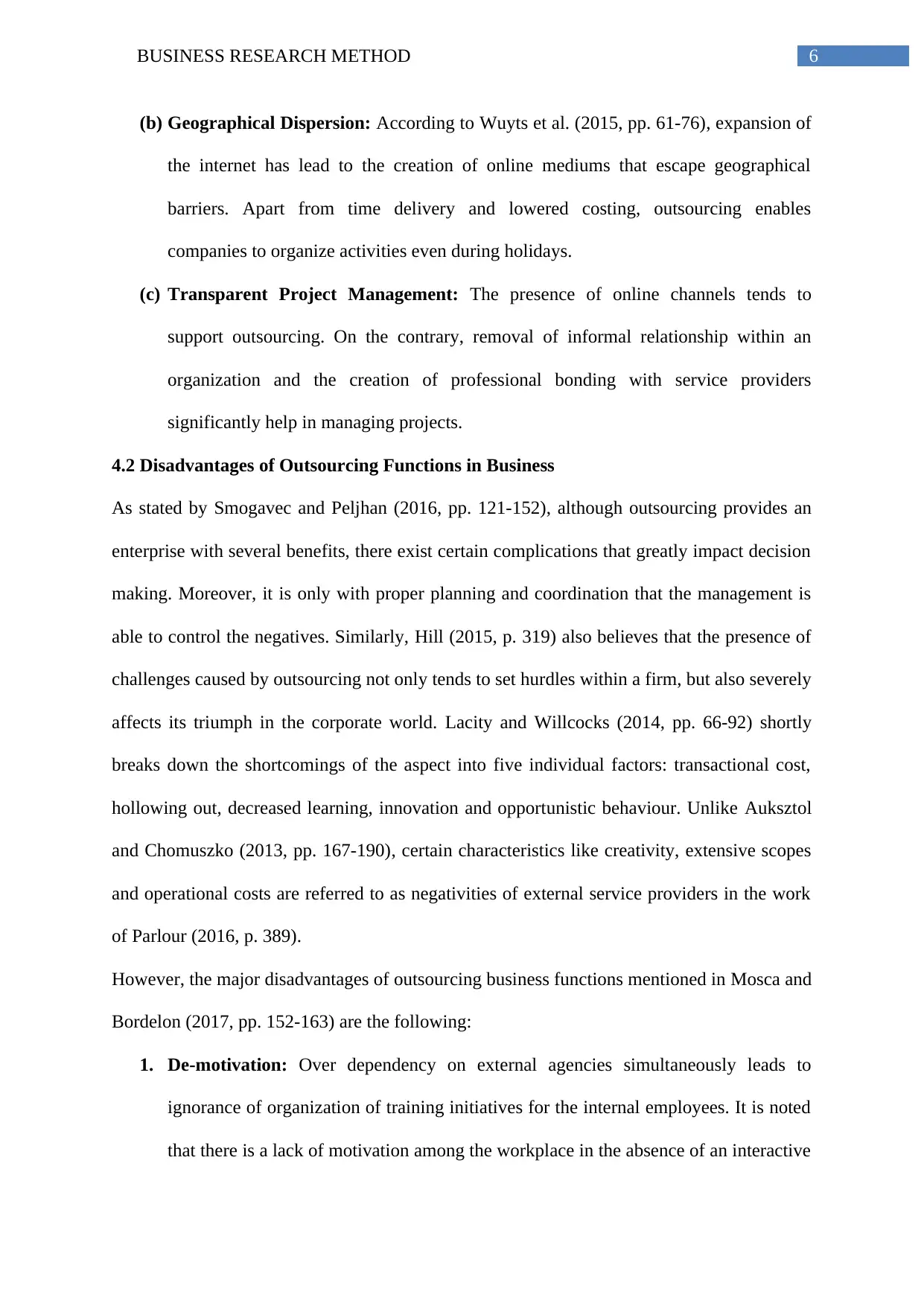
6BUSINESS RESEARCH METHOD
(b) Geographical Dispersion: According to Wuyts et al. (2015, pp. 61-76), expansion of
the internet has lead to the creation of online mediums that escape geographical
barriers. Apart from time delivery and lowered costing, outsourcing enables
companies to organize activities even during holidays.
(c) Transparent Project Management: The presence of online channels tends to
support outsourcing. On the contrary, removal of informal relationship within an
organization and the creation of professional bonding with service providers
significantly help in managing projects.
4.2 Disadvantages of Outsourcing Functions in Business
As stated by Smogavec and Peljhan (2016, pp. 121-152), although outsourcing provides an
enterprise with several benefits, there exist certain complications that greatly impact decision
making. Moreover, it is only with proper planning and coordination that the management is
able to control the negatives. Similarly, Hill (2015, p. 319) also believes that the presence of
challenges caused by outsourcing not only tends to set hurdles within a firm, but also severely
affects its triumph in the corporate world. Lacity and Willcocks (2014, pp. 66-92) shortly
breaks down the shortcomings of the aspect into five individual factors: transactional cost,
hollowing out, decreased learning, innovation and opportunistic behaviour. Unlike Auksztol
and Chomuszko (2013, pp. 167-190), certain characteristics like creativity, extensive scopes
and operational costs are referred to as negativities of external service providers in the work
of Parlour (2016, p. 389).
However, the major disadvantages of outsourcing business functions mentioned in Mosca and
Bordelon (2017, pp. 152-163) are the following:
1. De-motivation: Over dependency on external agencies simultaneously leads to
ignorance of organization of training initiatives for the internal employees. It is noted
that there is a lack of motivation among the workplace in the absence of an interactive
(b) Geographical Dispersion: According to Wuyts et al. (2015, pp. 61-76), expansion of
the internet has lead to the creation of online mediums that escape geographical
barriers. Apart from time delivery and lowered costing, outsourcing enables
companies to organize activities even during holidays.
(c) Transparent Project Management: The presence of online channels tends to
support outsourcing. On the contrary, removal of informal relationship within an
organization and the creation of professional bonding with service providers
significantly help in managing projects.
4.2 Disadvantages of Outsourcing Functions in Business
As stated by Smogavec and Peljhan (2016, pp. 121-152), although outsourcing provides an
enterprise with several benefits, there exist certain complications that greatly impact decision
making. Moreover, it is only with proper planning and coordination that the management is
able to control the negatives. Similarly, Hill (2015, p. 319) also believes that the presence of
challenges caused by outsourcing not only tends to set hurdles within a firm, but also severely
affects its triumph in the corporate world. Lacity and Willcocks (2014, pp. 66-92) shortly
breaks down the shortcomings of the aspect into five individual factors: transactional cost,
hollowing out, decreased learning, innovation and opportunistic behaviour. Unlike Auksztol
and Chomuszko (2013, pp. 167-190), certain characteristics like creativity, extensive scopes
and operational costs are referred to as negativities of external service providers in the work
of Parlour (2016, p. 389).
However, the major disadvantages of outsourcing business functions mentioned in Mosca and
Bordelon (2017, pp. 152-163) are the following:
1. De-motivation: Over dependency on external agencies simultaneously leads to
ignorance of organization of training initiatives for the internal employees. It is noted
that there is a lack of motivation among the workplace in the absence of an interactive
Paraphrase This Document
Need a fresh take? Get an instant paraphrase of this document with our AI Paraphraser
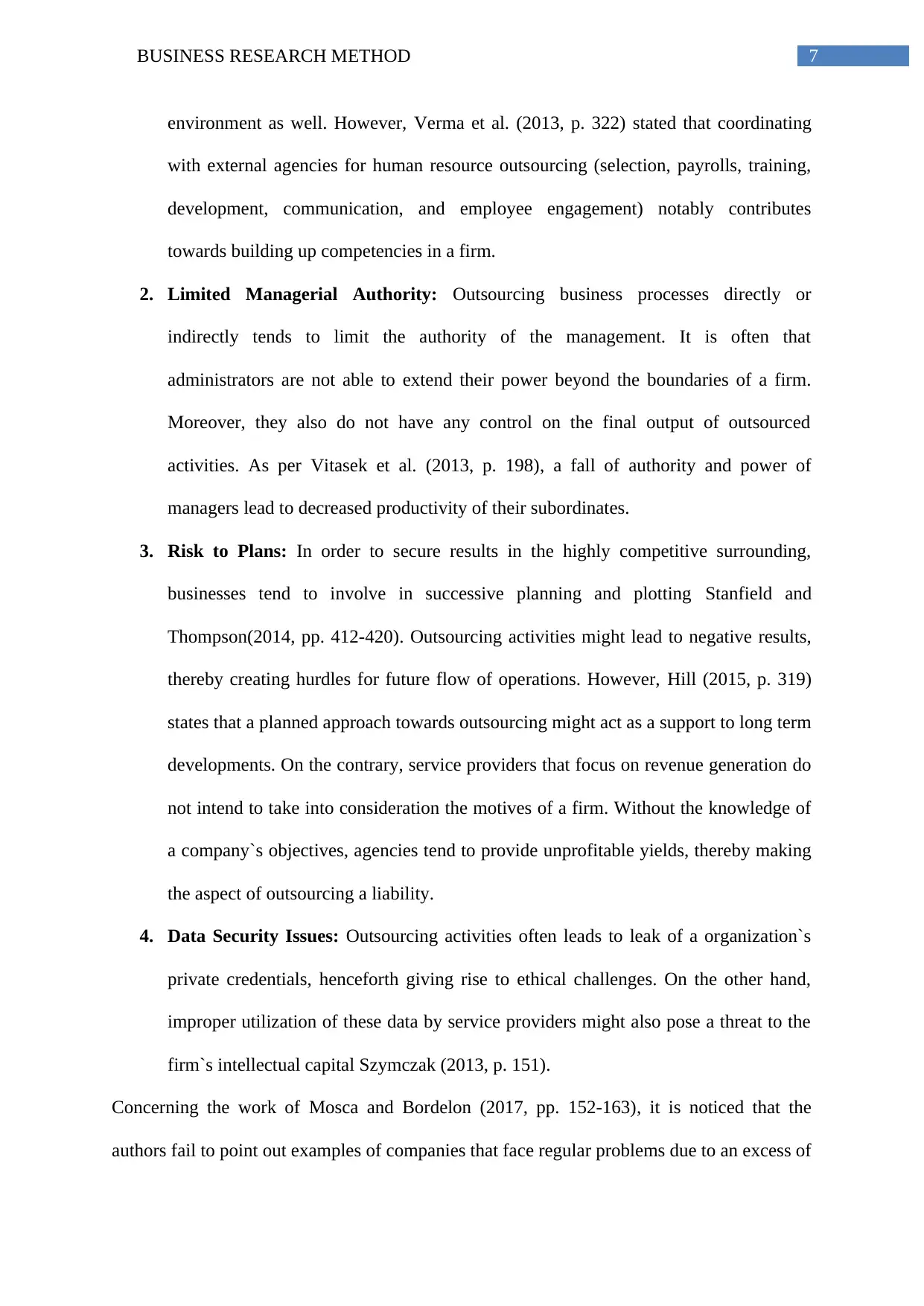
7BUSINESS RESEARCH METHOD
environment as well. However, Verma et al. (2013, p. 322) stated that coordinating
with external agencies for human resource outsourcing (selection, payrolls, training,
development, communication, and employee engagement) notably contributes
towards building up competencies in a firm.
2. Limited Managerial Authority: Outsourcing business processes directly or
indirectly tends to limit the authority of the management. It is often that
administrators are not able to extend their power beyond the boundaries of a firm.
Moreover, they also do not have any control on the final output of outsourced
activities. As per Vitasek et al. (2013, p. 198), a fall of authority and power of
managers lead to decreased productivity of their subordinates.
3. Risk to Plans: In order to secure results in the highly competitive surrounding,
businesses tend to involve in successive planning and plotting Stanfield and
Thompson(2014, pp. 412-420). Outsourcing activities might lead to negative results,
thereby creating hurdles for future flow of operations. However, Hill (2015, p. 319)
states that a planned approach towards outsourcing might act as a support to long term
developments. On the contrary, service providers that focus on revenue generation do
not intend to take into consideration the motives of a firm. Without the knowledge of
a company`s objectives, agencies tend to provide unprofitable yields, thereby making
the aspect of outsourcing a liability.
4. Data Security Issues: Outsourcing activities often leads to leak of a organization`s
private credentials, henceforth giving rise to ethical challenges. On the other hand,
improper utilization of these data by service providers might also pose a threat to the
firm`s intellectual capital Szymczak (2013, p. 151).
Concerning the work of Mosca and Bordelon (2017, pp. 152-163), it is noticed that the
authors fail to point out examples of companies that face regular problems due to an excess of
environment as well. However, Verma et al. (2013, p. 322) stated that coordinating
with external agencies for human resource outsourcing (selection, payrolls, training,
development, communication, and employee engagement) notably contributes
towards building up competencies in a firm.
2. Limited Managerial Authority: Outsourcing business processes directly or
indirectly tends to limit the authority of the management. It is often that
administrators are not able to extend their power beyond the boundaries of a firm.
Moreover, they also do not have any control on the final output of outsourced
activities. As per Vitasek et al. (2013, p. 198), a fall of authority and power of
managers lead to decreased productivity of their subordinates.
3. Risk to Plans: In order to secure results in the highly competitive surrounding,
businesses tend to involve in successive planning and plotting Stanfield and
Thompson(2014, pp. 412-420). Outsourcing activities might lead to negative results,
thereby creating hurdles for future flow of operations. However, Hill (2015, p. 319)
states that a planned approach towards outsourcing might act as a support to long term
developments. On the contrary, service providers that focus on revenue generation do
not intend to take into consideration the motives of a firm. Without the knowledge of
a company`s objectives, agencies tend to provide unprofitable yields, thereby making
the aspect of outsourcing a liability.
4. Data Security Issues: Outsourcing activities often leads to leak of a organization`s
private credentials, henceforth giving rise to ethical challenges. On the other hand,
improper utilization of these data by service providers might also pose a threat to the
firm`s intellectual capital Szymczak (2013, p. 151).
Concerning the work of Mosca and Bordelon (2017, pp. 152-163), it is noticed that the
authors fail to point out examples of companies that face regular problems due to an excess of
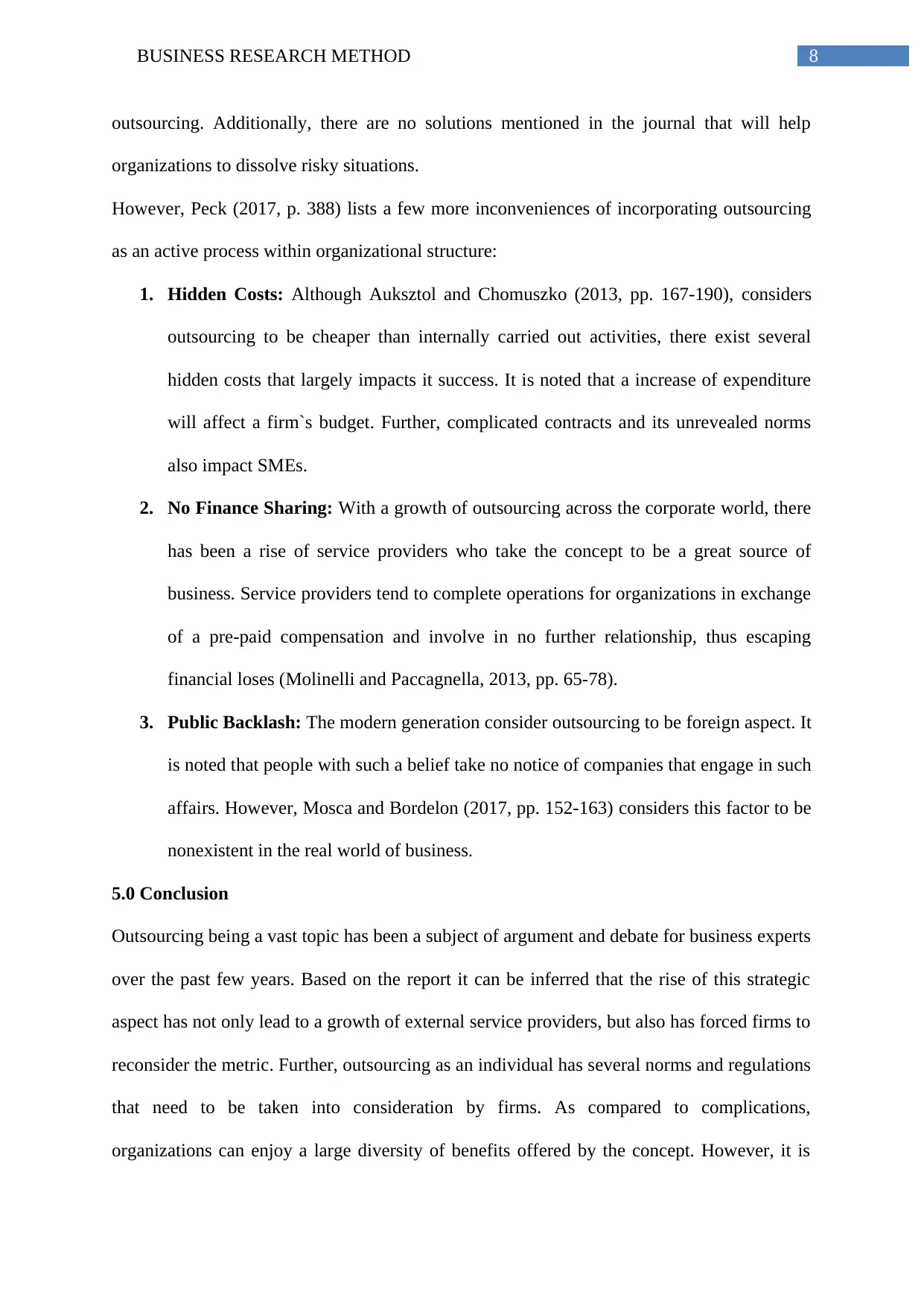
8BUSINESS RESEARCH METHOD
outsourcing. Additionally, there are no solutions mentioned in the journal that will help
organizations to dissolve risky situations.
However, Peck (2017, p. 388) lists a few more inconveniences of incorporating outsourcing
as an active process within organizational structure:
1. Hidden Costs: Although Auksztol and Chomuszko (2013, pp. 167-190), considers
outsourcing to be cheaper than internally carried out activities, there exist several
hidden costs that largely impacts it success. It is noted that a increase of expenditure
will affect a firm`s budget. Further, complicated contracts and its unrevealed norms
also impact SMEs.
2. No Finance Sharing: With a growth of outsourcing across the corporate world, there
has been a rise of service providers who take the concept to be a great source of
business. Service providers tend to complete operations for organizations in exchange
of a pre-paid compensation and involve in no further relationship, thus escaping
financial loses (Molinelli and Paccagnella, 2013, pp. 65-78).
3. Public Backlash: The modern generation consider outsourcing to be foreign aspect. It
is noted that people with such a belief take no notice of companies that engage in such
affairs. However, Mosca and Bordelon (2017, pp. 152-163) considers this factor to be
nonexistent in the real world of business.
5.0 Conclusion
Outsourcing being a vast topic has been a subject of argument and debate for business experts
over the past few years. Based on the report it can be inferred that the rise of this strategic
aspect has not only lead to a growth of external service providers, but also has forced firms to
reconsider the metric. Further, outsourcing as an individual has several norms and regulations
that need to be taken into consideration by firms. As compared to complications,
organizations can enjoy a large diversity of benefits offered by the concept. However, it is
outsourcing. Additionally, there are no solutions mentioned in the journal that will help
organizations to dissolve risky situations.
However, Peck (2017, p. 388) lists a few more inconveniences of incorporating outsourcing
as an active process within organizational structure:
1. Hidden Costs: Although Auksztol and Chomuszko (2013, pp. 167-190), considers
outsourcing to be cheaper than internally carried out activities, there exist several
hidden costs that largely impacts it success. It is noted that a increase of expenditure
will affect a firm`s budget. Further, complicated contracts and its unrevealed norms
also impact SMEs.
2. No Finance Sharing: With a growth of outsourcing across the corporate world, there
has been a rise of service providers who take the concept to be a great source of
business. Service providers tend to complete operations for organizations in exchange
of a pre-paid compensation and involve in no further relationship, thus escaping
financial loses (Molinelli and Paccagnella, 2013, pp. 65-78).
3. Public Backlash: The modern generation consider outsourcing to be foreign aspect. It
is noted that people with such a belief take no notice of companies that engage in such
affairs. However, Mosca and Bordelon (2017, pp. 152-163) considers this factor to be
nonexistent in the real world of business.
5.0 Conclusion
Outsourcing being a vast topic has been a subject of argument and debate for business experts
over the past few years. Based on the report it can be inferred that the rise of this strategic
aspect has not only lead to a growth of external service providers, but also has forced firms to
reconsider the metric. Further, outsourcing as an individual has several norms and regulations
that need to be taken into consideration by firms. As compared to complications,
organizations can enjoy a large diversity of benefits offered by the concept. However, it is
⊘ This is a preview!⊘
Do you want full access?
Subscribe today to unlock all pages.

Trusted by 1+ million students worldwide

9BUSINESS RESEARCH METHOD
only with the construction, controlling and coordination of proper plans that an enterprise can
enjoy the several advantages of outsourcing. On the other hand, it is also noticed that there
exist a detailed discussion about the concept in the works of various authors. However, some
of them fail to recognize important factors like SMEs, real situations and solutions in their
books, articles or journals.
only with the construction, controlling and coordination of proper plans that an enterprise can
enjoy the several advantages of outsourcing. On the other hand, it is also noticed that there
exist a detailed discussion about the concept in the works of various authors. However, some
of them fail to recognize important factors like SMEs, real situations and solutions in their
books, articles or journals.
Paraphrase This Document
Need a fresh take? Get an instant paraphrase of this document with our AI Paraphraser
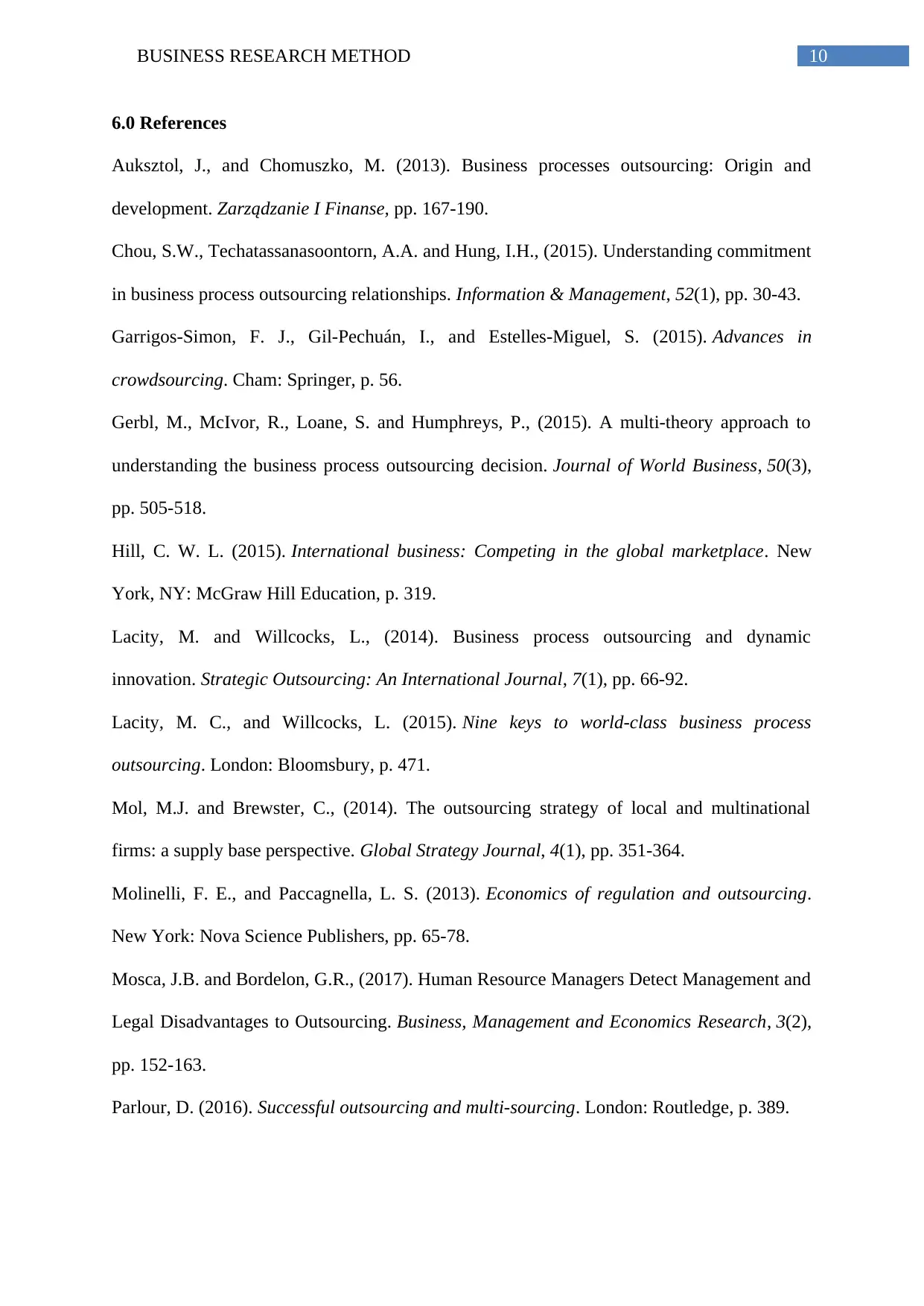
10BUSINESS RESEARCH METHOD
6.0 References
Auksztol, J., and Chomuszko, M. (2013). Business processes outsourcing: Origin and
development. Zarządzanie I Finanse, pp. 167-190.
Chou, S.W., Techatassanasoontorn, A.A. and Hung, I.H., (2015). Understanding commitment
in business process outsourcing relationships. Information & Management, 52(1), pp. 30-43.
Garrigos-Simon, F. J., Gil-Pechuán, I., and Estelles-Miguel, S. (2015). Advances in
crowdsourcing. Cham: Springer, p. 56.
Gerbl, M., McIvor, R., Loane, S. and Humphreys, P., (2015). A multi-theory approach to
understanding the business process outsourcing decision. Journal of World Business, 50(3),
pp. 505-518.
Hill, C. W. L. (2015). International business: Competing in the global marketplace. New
York, NY: McGraw Hill Education, p. 319.
Lacity, M. and Willcocks, L., (2014). Business process outsourcing and dynamic
innovation. Strategic Outsourcing: An International Journal, 7(1), pp. 66-92.
Lacity, M. C., and Willcocks, L. (2015). Nine keys to world-class business process
outsourcing. London: Bloomsbury, p. 471.
Mol, M.J. and Brewster, C., (2014). The outsourcing strategy of local and multinational
firms: a supply base perspective. Global Strategy Journal, 4(1), pp. 351-364.
Molinelli, F. E., and Paccagnella, L. S. (2013). Economics of regulation and outsourcing.
New York: Nova Science Publishers, pp. 65-78.
Mosca, J.B. and Bordelon, G.R., (2017). Human Resource Managers Detect Management and
Legal Disadvantages to Outsourcing. Business, Management and Economics Research, 3(2),
pp. 152-163.
Parlour, D. (2016). Successful outsourcing and multi-sourcing. London: Routledge, p. 389.
6.0 References
Auksztol, J., and Chomuszko, M. (2013). Business processes outsourcing: Origin and
development. Zarządzanie I Finanse, pp. 167-190.
Chou, S.W., Techatassanasoontorn, A.A. and Hung, I.H., (2015). Understanding commitment
in business process outsourcing relationships. Information & Management, 52(1), pp. 30-43.
Garrigos-Simon, F. J., Gil-Pechuán, I., and Estelles-Miguel, S. (2015). Advances in
crowdsourcing. Cham: Springer, p. 56.
Gerbl, M., McIvor, R., Loane, S. and Humphreys, P., (2015). A multi-theory approach to
understanding the business process outsourcing decision. Journal of World Business, 50(3),
pp. 505-518.
Hill, C. W. L. (2015). International business: Competing in the global marketplace. New
York, NY: McGraw Hill Education, p. 319.
Lacity, M. and Willcocks, L., (2014). Business process outsourcing and dynamic
innovation. Strategic Outsourcing: An International Journal, 7(1), pp. 66-92.
Lacity, M. C., and Willcocks, L. (2015). Nine keys to world-class business process
outsourcing. London: Bloomsbury, p. 471.
Mol, M.J. and Brewster, C., (2014). The outsourcing strategy of local and multinational
firms: a supply base perspective. Global Strategy Journal, 4(1), pp. 351-364.
Molinelli, F. E., and Paccagnella, L. S. (2013). Economics of regulation and outsourcing.
New York: Nova Science Publishers, pp. 65-78.
Mosca, J.B. and Bordelon, G.R., (2017). Human Resource Managers Detect Management and
Legal Disadvantages to Outsourcing. Business, Management and Economics Research, 3(2),
pp. 152-163.
Parlour, D. (2016). Successful outsourcing and multi-sourcing. London: Routledge, p. 389.
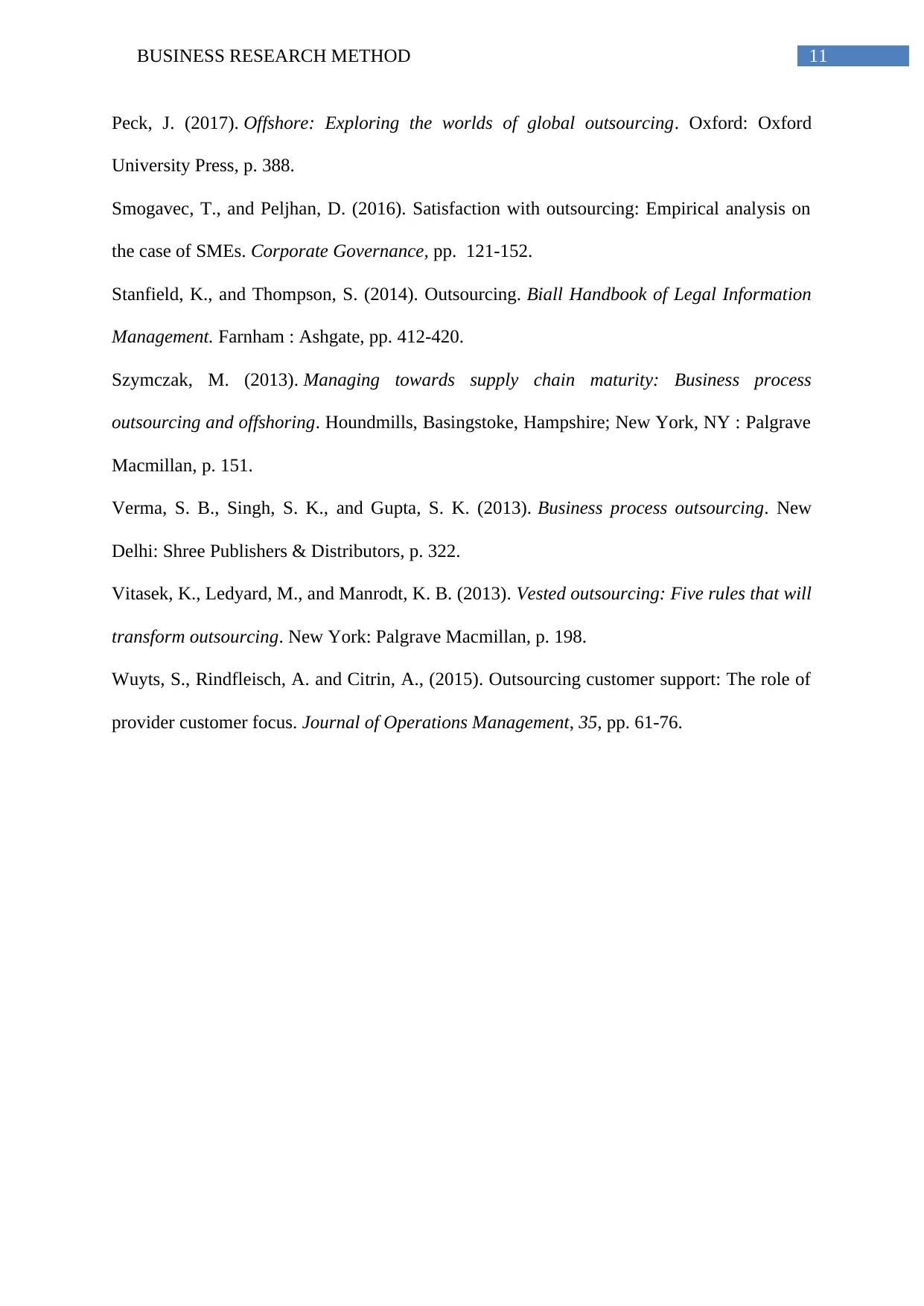
11BUSINESS RESEARCH METHOD
Peck, J. (2017). Offshore: Exploring the worlds of global outsourcing. Oxford: Oxford
University Press, p. 388.
Smogavec, T., and Peljhan, D. (2016). Satisfaction with outsourcing: Empirical analysis on
the case of SMEs. Corporate Governance, pp. 121-152.
Stanfield, K., and Thompson, S. (2014). Outsourcing. Biall Handbook of Legal Information
Management. Farnham : Ashgate, pp. 412-420.
Szymczak, M. (2013). Managing towards supply chain maturity: Business process
outsourcing and offshoring. Houndmills, Basingstoke, Hampshire; New York, NY : Palgrave
Macmillan, p. 151.
Verma, S. B., Singh, S. K., and Gupta, S. K. (2013). Business process outsourcing. New
Delhi: Shree Publishers & Distributors, p. 322.
Vitasek, K., Ledyard, M., and Manrodt, K. B. (2013). Vested outsourcing: Five rules that will
transform outsourcing. New York: Palgrave Macmillan, p. 198.
Wuyts, S., Rindfleisch, A. and Citrin, A., (2015). Outsourcing customer support: The role of
provider customer focus. Journal of Operations Management, 35, pp. 61-76.
Peck, J. (2017). Offshore: Exploring the worlds of global outsourcing. Oxford: Oxford
University Press, p. 388.
Smogavec, T., and Peljhan, D. (2016). Satisfaction with outsourcing: Empirical analysis on
the case of SMEs. Corporate Governance, pp. 121-152.
Stanfield, K., and Thompson, S. (2014). Outsourcing. Biall Handbook of Legal Information
Management. Farnham : Ashgate, pp. 412-420.
Szymczak, M. (2013). Managing towards supply chain maturity: Business process
outsourcing and offshoring. Houndmills, Basingstoke, Hampshire; New York, NY : Palgrave
Macmillan, p. 151.
Verma, S. B., Singh, S. K., and Gupta, S. K. (2013). Business process outsourcing. New
Delhi: Shree Publishers & Distributors, p. 322.
Vitasek, K., Ledyard, M., and Manrodt, K. B. (2013). Vested outsourcing: Five rules that will
transform outsourcing. New York: Palgrave Macmillan, p. 198.
Wuyts, S., Rindfleisch, A. and Citrin, A., (2015). Outsourcing customer support: The role of
provider customer focus. Journal of Operations Management, 35, pp. 61-76.
⊘ This is a preview!⊘
Do you want full access?
Subscribe today to unlock all pages.

Trusted by 1+ million students worldwide
1 out of 12
Related Documents
Your All-in-One AI-Powered Toolkit for Academic Success.
+13062052269
info@desklib.com
Available 24*7 on WhatsApp / Email
![[object Object]](/_next/static/media/star-bottom.7253800d.svg)
Unlock your academic potential
Copyright © 2020–2025 A2Z Services. All Rights Reserved. Developed and managed by ZUCOL.





